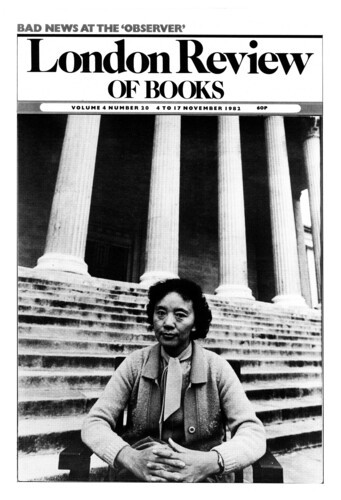The painter Rory McEwen, who died on 16 October, was born, the fourth of seven children, on 12 March 1932. The family was Catholic, and his father a Conservative politician. His childhood was spent at the beautiful house of Marchmont, set in the storied countryside of the Merse in Berwickshire. The landscape is apparent if we go, as Rory did, to the work of another local talent, Alexander Hume, who flourished four hundred years earlier. In his poem, ‘Of the Day Estivall’, the natural world is seen in a state of trance:
All trees and simples great and small,
That balmy leaf do bear,
Nor they were painted on a wall,
Na mair they move or stir.
There would come a time when these leaves and herbs would indeed be painted on a wall.
Rory was a boy of wonderfully nimble fingers, typed as the craftsman – the origamist, electrician, fly-tier, trout-guddler, model aeroplane-maker, puppet theatre-master – of this household of rival capacities, of ‘the McEwen compound’, which he was never, in a sense, to leave, but which did not dampen his ardour for the outside world. He was never Bridesheaded. The ‘Box of Delights’ made by ‘Pin’ at 16 as a Christmas present for his delightful and commanding mother is among his best achievements. Meanwhile, in the Marchmont playroom, the Humphrey Lyttelton 78’s began to turn, and Rory began to sing: his own gay songs, Border Ballads, the Blues – learnt from Leadbelly and Louis Armstrong. He was educated at Eton, became a National Service officer with the Cameron Highlanders, and went on to read English at Cambridge. It is possible to imagine the eyes of the Fifties meritocracy dwelling on the romantic figure in the Inverness cape, Scots bonnet and tartan trews, a pheasant in one hand, a beribboned guitar in the other: but it is hard to imagine that he was resented. In 1958 he married Romana von Hofmannsthal – an artist herself, eventually. Three daughters and a son were born.
It can be said that around the age of thirty, having diverted himself with cartoons and television calypsos, he settled to his art. It can also be said, however, that it was an art of which he was already a master. He was already known for his flower pictures, in the tradition of Redouté and Le Moyne. But he was now entering an art world ruled by theories rarely indulgent to that tradition. ‘Probably the greatest living illustrator of natural form’, one of his most understanding and appreciative critics, Alistair Mackintosh, has written, had to search for ‘conceptual pegs’ to make his art ‘acceptable to contemporary eyes’. Nimbleness, versatility, became eclecticism. He was alive to new orthodoxies, Vanguard pursuits, to photography and to concepts of mass production.
In most of these activities – the perspex sculptures, for example – his skills as a maker survived, though he was no longer to bear much resemblance to some monkish illustrator. The little show of leaves at the Taranman Gallery in 1979 was a consequence of his early carnations, and spoke of a continuity in his work. A tension had come about between great and small, magnification and verisimilitude. At its quintessential best, the art of his later years was to deliver, life-size, a single autumn leaf – placed off-centre on a vellum page, with every tint or capillary caught, the tiny brush-strokes barely decipherable.
This is not the balmy leaf of the Day Estivall. Touched with decay, with russet, it might almost be the fallen leaf of requiem or elegy. Neither is it the typical leaf, fashioned as a scientific specimen. His flowers and fruit and roots were, from the first, neither botany nor calligraphy. Even at his least traditional and generic, he is self-subduing, and his line can at times give a sense of costraint, which evokes the disciplines of a craft, and other disciplines too. But he is present, he expressed himself, in everything he did. His floral work can be consulted in books and in museums, and his art will be valued when many of the theories of his lifetime have faded.
Rory McEwen was startling and stylish and witty, and yet shy and kind and wholesome. He will live for his friends in each of the embodiments of his versatility. In hospital, during his long illness, he would wear the white lawns or linens of a translucent Indian trouser suit, and a turban obtained from the Sikhs of North London, with a costume jewel planted in the centre and surmounted by a very tall feather. Beside the rajah’s bed lay his water-colour paints and brushes, and – freer in style than those of his early days – a last picture of a flower.
Send Letters To:
The Editor
London Review of Books,
28 Little Russell Street
London, WC1A 2HN
letters@lrb.co.uk
Please include name, address, and a telephone number.

